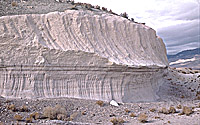


| The Bishop Tuff refers to the deposits of ash and pumice ejected during the enormous eruption that created Long Valley Caldera. Scientists estimate that more than 50 km3 of tephra was disperesed widely as ashfall, and as much as about 700 km3 of magma erupted as pyroclastic flows, most of which ponded and welded together within the caldera (~500 km3). Outside the caldera, these pyroclastic flows swept over an area of more than 2,200 km2 and buried the pre-existing ground to depths of nearly 200 m just south of the caldera. These pyroclastic flow deposits show various degrees of welding. The Bishop Tuff can be divided into 8 different layers that are easily distinguished in the field. |

|
Bishop Tuff airfall deposits exposed in a rock quarry near Laws in Chalfant Valley, California. |

